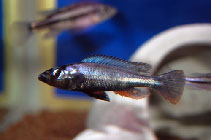| Family: |
Cichlidae (Cichlids), subfamily: Pseudocrenilabrinae |
| Max. size: |
8.2 cm SL (male/unsexed); 7.63 cm SL (female) |
| Environment: |
benthopelagic; freshwater |
| Distribution: |
Africa: Lake Victoria. |
| Diagnosis: |
Dorsal spines (total): 15-16; Dorsal soft rays (total): 8-10; Anal spines: 3-3; Anal soft rays: 7-10; Vertebrae: 29-32. Small, slender, laterally compressed body (Ref. 47153). A rather acutely pointed snout (Ref. 47153). Lips slightly thickened (Ref. 47153). Lower jaw ventral outline almost straight, the rostral outline of lower jaw straight or slightly convex with a smoothly rounded mental area (Ref. 47153). Pectoral fins just reaching the anus; dorsal fin rays slightly longer than those of the anal fin, nearly reaching the caudal fin base (Ref. 47153). All scales on the head are cycloid; scales on rostral part of dorsum cycloid or very weakly ctenoid, caudal part of dorsum with ctenoid scales; scales on flank and caudal peduncle ctenoid; ventral chest scales small and cycloid, lateral chest scales moderately small, weakly ctenoid (Ref. 47153).Live basic color for males is bluish-grey dorsally and silvery white ventrally, sexually active males have a pitch black head and body; females and juveniles have a distinct, relatively thin mid lateral band, but the cheek of the females are slightly more greyish (Ref. 47153). Two continuous longitudinal bands on the body (Ref. 47153). |
| Biology: |
Haplochromis thereuterion occurs in the upper layers of the water column in Lake Victoria (Ref. 47153). |
| IUCN Red List Status: |
Vulnerable (VU); Date assessed: 31 March 2010 (D2) Ref. (130435)
|
| Threat to humans: |
harmless |
Source and more info: www.fishbase.org. For personal, classroom, and other internal use only. Not for publication.

